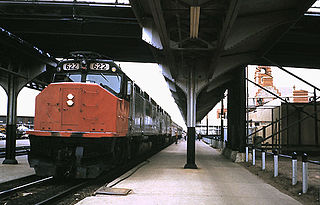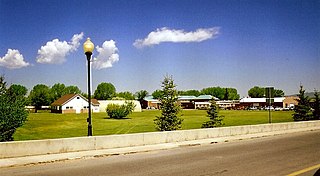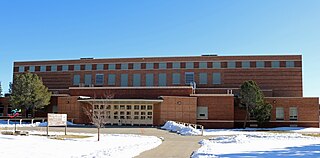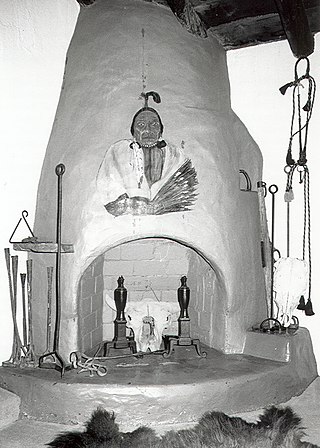
The Wyoming State Capitol is the state capitol and seat of government of the U.S. state of Wyoming. Built between 1886 and 1890, the capitol is located in Cheyenne and contains the chambers of the Wyoming State Legislature as well as the office of the Governor of Wyoming. It was designated a U.S. National Historic Landmark in 1987. The Capitol underwent an extensive three-year renovation and reopened to the public on July 10, 2019.

The Cheyenne Depot Museum is a railroad museum in Cheyenne, Wyoming, United States. It is located inside the 1880s Union Pacific Railroad depot. A National Historic Landmark, the station was the railroad's largest west of Council Bluffs, Iowa, and a major western example of Richardsonian Romanesque architecture.

The Old Faithful Historic District in Yellowstone National Park comprises the built-up portion of the Upper Geyser Basin surrounding the Old Faithful Inn and Old Faithful Geyser. It includes the Old Faithful Inn, designed by Robert Reamer and is itself a National Historic Landmark, the upper and lower Hamilton's Stores, the Old Faithful Lodge, designed by Gilbert Stanley Underwood, the Old Faithful Snow Lodge, and a variety of supporting buildings. The Old Faithful Historic District itself lies on the 140-mile Grand Loop Road Historic District.

Menor's Ferry was a river ferry that crossed the Snake River near the present-day Moose, Wyoming, United States. The site was homesteaded by Bill Menor in 1892-94, choosing a location where the river flowed in a single channel, rather than the braided stream that characterizes its course in most of Jackson Hole. During the 1890s it was the only homestead west of the river. Menor's homestead included a five-room cabin, a barn, a store, sheds and an icehouse on 148 acres (60 ha), irrigated by a ditch from Cottonwood Creek and at times supplemented by water raised from the Snake River by a waterwheel. Menor operated the ferry until 1918, selling to Maude Noble, who continued operations until 1927, when a bridge was built at Moose.

The Wyoming State Hospital, once known as the Wyoming State Insane Asylum, is located in Evanston, Wyoming, United States. The historic district occupies the oldest portion of the grounds and includes fifteen contributing buildings, including the main administrative building, staff and patient dormitories, staff apartments and houses, a cafeteria and other buildings, many of which were designed by Cheyenne, Wyoming architect William Dubois. Established in 1887, the historic buildings span the period 1907-1948. At one point it was common for new hall additions to be named after the counties in Wyoming. The recent addition of Aspen, Cottonwood, and Evergreen halls do not follow this trend.
The Rosencrans Cabin is part of a small historic district comprising five log buildings on three acres in Bridger-Teton National Forest, just east of Grand Teton National Park. The cabin was used by Rudolph "Rosie" Rosencrans, who played a role in the development of Teton National Forest and who later became a U.S. Forest Service administrator in the early 20th century. Rosencrans was buried at this location.

The Sheridan Flouring Mills, also known as the Mill Inn, are an industrial complex in Sheridan, Wyoming. The mills were a major component of the economy of north central Wyoming, providing collection, storage and milling of locally produced wheat and other grains into flour and other milled products. The original mill was established by Captain Scott W. Snively in the early 1890s. The Sheridan Milling and Manufacturing Company was sold to J.W. Denio in 1903, who operated the mill at its location on Broadway Avenue near downtown Sheridan. A catastrophic fire destroyed this mill in 1919, resulting in the purchase of a new location on Coffeen Avenue and construction of a much larger mill.

The Masonic Temple in Cheyenne, Wyoming, is a building dating from 1901. It was listed on the National Register of Historic Places in 1984.

William Dubois (1879–1953) was an American architect and politician. He was a prolific architect in Wyoming and nearby states, and served five terms in both houses of the Wyoming Legislature.
Frederic Hutchinson "Bunk" Porter, Sr., sometimes referred to as Frederick Hutchinson Porter, was an American architect based in Cheyenne, Wyoming. He was active from 1911 to approximately 1965. He designed many of Cheyenne's most important public and commercial buildings and also designed several buildings at the University of Wyoming, including War Memorial Stadium and the Agriculture Building. A number of his works are listed on the U.S. National Register of Historic Places.

The Jim Baker Cabin was built in 1873 by frontiersman Jim Baker as a fortified house on the Little Snake River at Savery Creek near present-day Savery, Wyoming. The two-story log building measures 31 feet (9.4 m) by 16 feet (4.9 m) with two rooms on the lower level and a single smaller room on the upper level. The outer walls are made of logs 12 inches (30 cm) to 15 inches (38 cm) thick.

The Fremont, Elkhorn & Missouri Valley Railroad Passenger Depot, also known as the Chicago and North Western Railway Passenger Depot and presently as the Douglas Railroad Interpretive Center, was built in 1886 in Douglas, Wyoming to accommodate traffic on the Fremont, Elkhorn and Missouri Valley Railroad's (FE&MV) terminus at the newly built town. The depot was built as a fairly small, cautious investment in a possibly ephemeral frontier town. Immediately following the completion of the depot Douglas saw an epidemic of typhoid fever and the worst winter in a generation, and the railroad decided to push on to Casper for its terminus. The town's population declined from 1600 in 1886 to 900 in 1888. By 1891 Owen Wister reported that Douglas had a population of about 350. However, by 1910 Douglas had 2246 residents and hosted the Wyoming State Fair. The presence of the fair stimulated rail traffic, while the FE&MV merged with the Cheyenne and Northern Railway in 1903. In 1905 oil development started. In the 1950s coal mining began for the Dave Johnson Power Plant and the railway expanded its Douglas facilities to accommodate the traffic, closing the original depot and building a larger facility. The depot was acquired from the railroad's successor, the Chicago and North Western Railway, by the city in 1990.

Storey Gymnasium, also known as Cheyenne High School Gymnasium, was built in 1950 on the campus of Central High School in Cheyenne, Wyoming, United States. The brick gymnasium was designed by Cheyenne architect Frederic Hutchinson Porter to include additional functions associated with the school's ROTC program, with an armory, rifle range and drill halls in addition to classrooms, shops and music spaces. The contractor was Loren Hancock, who built it at a cost of $646,611.66. It was named for William Storey, a member of the school Board of Trustees. When East High School was built in 1965 the facility was shared between East and Central.

The Rainbow Conoco at 400 Main St. in Shelby, Montana, also known as Joe's, was built in 1936. It was listed on the National Register of Historic Places in 1994.

The Cheyenne Flour Milling Company, also known as the Standard Oil Company and Salt Creek Freightways, is an early warehouse building in Cheyenne, Wyoming. The structure was built in 1927 to house goods brought to and from Cheyenne by the Union Pacific Railroad in an industrial section of Cheyenne as a flour mill, replacing structures that had performed similar functions since 1915. By 1931 the building was shared by a warehouse for electrical parts for the Mountain States Telephone and Telegraph Company, a potato chip factory and a chemical products company. In 1937-38 the Standard Oil Company started to use the warehouse for bulk petroleum products storage, continuing to 1963. From 1963 the building was used by Salt Creek Freightways, which had shared use from 1936. In 1973 it became a plumbing parts warehouse, and by 2003 was owned and used by a general contractor.

The Continental Oil Company building complex is a significant component of railroad-related economic activity in Cheyenne, Wyoming. Built beginning in 1905, the complex was used by the Continental Oil Company for bulk oil storage through much of the 20th century. The property was transferred to the Sioux Oil Company, which vacated the complex in 1990. In 2000 the property was occupied by a trailer sales business.

The Federal Office Building-Cheyenne, at 308 W. 21st St. in Cheyenne, Wyoming, is a Classical Revival-style building built in 1932. It was listed on the National Register of Historic Places in 2000.

The McCord-Brady Company, at 1506 Thomes Ave. in Cheyenne, Wyoming, was built in 1914–15. It was listed on the National Register of Historic Places in 2003. It has also been known as Asher-Wyoming Company Wholesale Grocers and as Cheyenne Winlectric Company.

Remount Ranch, in Laramie County, Wyoming near Cheyenne, Wyoming, is a pioneer cattle and horse ranch which dates from 1875. It was listed on the National Register of Historic Places in 1990. The listing included four contributing buildings and four contributing structures.

The Texas Oil Company in Cheyenne, Wyoming was built in 1915. It was listed on the National Register of Historic Places in 2003. The listing included two contributing buildings.




















